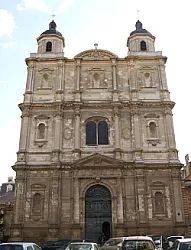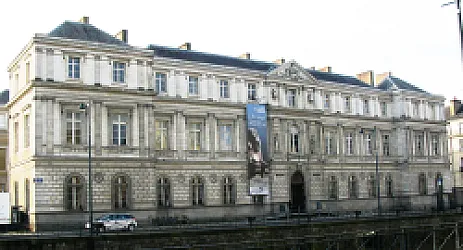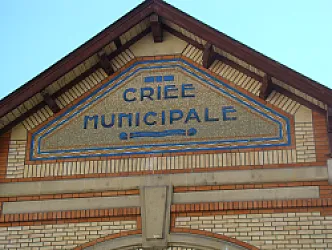Visit Rennes in 2 days
6 must-see POIs, optimized routes and anecdotes.
Loading map...
You will visit the most beautiful points of interest in Rennes
2 Days in Rennes — A Compact Love Letter to Brittany’s Spark
Rennes stole my heart the moment I stepped out into its lively squares. As the capital of Brittany, it feels both warm and mischievous. Some say it’s overrated, but I found it quietly brilliant. I remember my first coffee by a slate-roofed house and thinking, yes, this city sings. This short guide is born from that afternoon and a dozen little surprises I kept discovering.
Why visit? Because Rennes mixes history, art, and everyday magic in a way few cities do. The cobbled lanes hum with bicycle bells and bakery smells. You’ll roam from Église Toussaints de Rennes’s solemn stone to the bright canvases at the Museum of Fine Arts of Rennes. Then there’s La Criée, where performances make the air electric. This is not just about monuments. It’s about tasting buttered kouign-amann, hearing Breton accents, and feeling the city pulse at dusk.
Planning a trip can feel overwhelming. There’s so much to see you could easily spend weeks here. If it’s your first time in Rennes, you might worry about missing the best parts. I felt that too on my first visit. That’s exactly why I created this concise Rennes itinerary. Below, I’ll show you how to make the most of limited time. Expect three unmissable spots and enough local flavor to leave you wanting more.
Key tip: Start museum visits early and save late afternoons for wandering the old town. Crowds thin in the morning, and light on the stone facades is unbeatable near sunset. This pacing lets you savor art at the Museum of Fine Arts of Rennes, breathe in the calm at Église Toussaints de Rennes, and feel the theatre buzz at La Criée without rushing. Now let’s dive into the itinerary!

Quick Mini Guide to Rennes
Where to stay:
- Old Town (around Parlement de Bretagne) — walk to half-timbered streets, cafés and Musée des Beaux-Arts.
- Sainte-Anne / Théâtre area — easy access to La Criée and evening culture.
- Near République or train station for TGV links if arriving/ leaving quickly.
When to visit:
- Spring–early autumn for Parc du Thabor in bloom; weekends lively with students year-round.
- Saturday morning: Marché des Lices (local producers) — best local food and atmosphere.
- Check La Criée programme in advance for evening performances.
Things to do:
- Église Toussaints de Rennes — study the stained glass and quiet cloister away from the tourist flow.
- Museum of Fine Arts of Rennes — free permanent collection; plan 1–2 hours for highlights.
- La Criée — see a contemporary play or event; arrive early for nearby crêperies.
- Book The Alchemist RENNES — interactive cocktail lab good for a memorable evening with mixology and showmanship.
Don't forget:
- Try a Breton galette and cider in a small crêperie off Rue Saint-Georges.
- Buy a day tram ticket if staying outside the centre; Rennes is compact but hilly in parts.
- Weather can change quickly—carry a light rain layer, especially off-season.
Day 1 - Rennes
3 POIs to discoverDay 1 - Morning à Rennes
3 Points of interest - Duration : 3h30 - Distance : 0.5 km - Walking : 0h06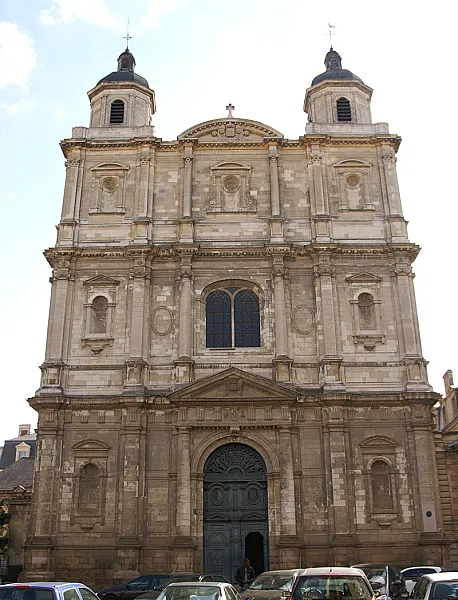
Église Toussaints de Rennes
- Toussaint Church, formerly the College Church, is a Catholic religious building in the counter-Reformation Baroque style.
- Built from 1624 to 1651, it was conceived as the church of the Collège Saint-Thomas, becoming a parish church in 1803.
- Under the Ancien Régime, it was rebuilt several times, the principal architects being Étienne Martellange, Charles Turmel and Pierre Goict.
- After the Revolution, the church underwent various uses before being demolished and rebuilt between 1801 and 1807, becoming the church of Toussaints.
- Classified as a historic monument in 1922, the church has been restored several times, most recently between 2013 and 2015.
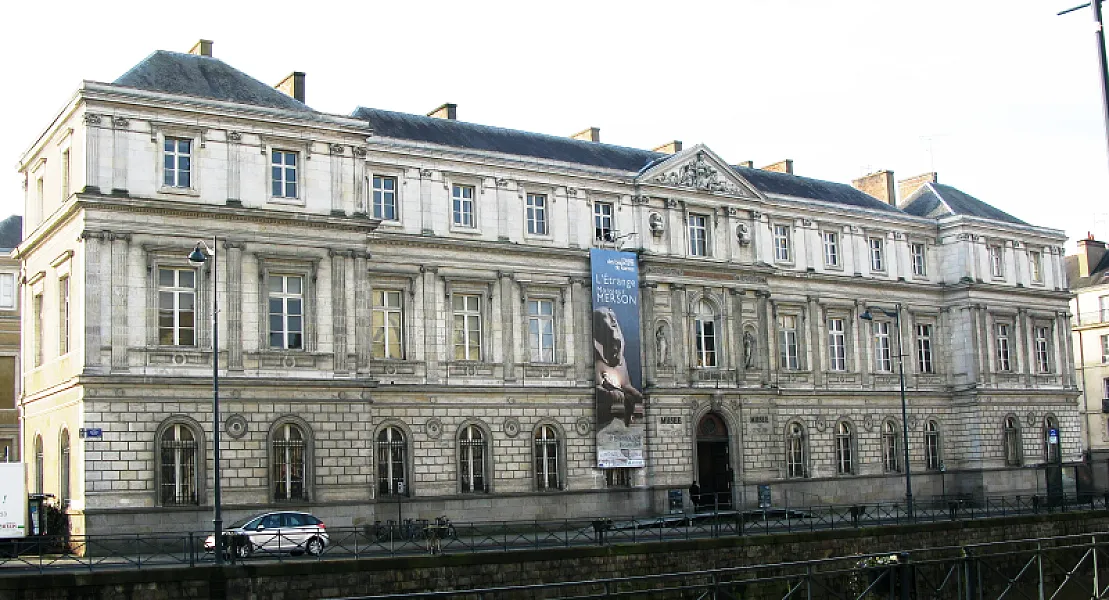
Museum of Fine Arts of Rennes
- The Musée des Beaux-Arts de Rennes is a museum of art and archaeology, founded with works seized during the revolutionary confiscations in 1794, and thanks to the collection of the Marquis de Robien.
- The museum is located in Rennes' former university palace and features an encyclopedic collection covering European paintings and sculptures from the 14th to the 20th century, objets d'art from Europe, Africa and America, as well as regional and Egyptian antiquities.
- The collections include archaeological objects such as Egyptian fragments from various periods, drawings largely from the collection of President de Robien, and prints by artists such as Dürer, Rembrandt, and Watteau.
- Painting and sculpture from the 14th to 18th centuries include works by Rubens, Le Brun, Van Dyck, La Tour, as well as the Italian, French and Northern schools.
- The 19th to 20th century collection features works by Caillebotte, Gauguin, Boudin, Rodin, and contemporary artists such as Picasso.
- The museum also boasts a library specializing in art history and general archaeology, with over 32,000 books.
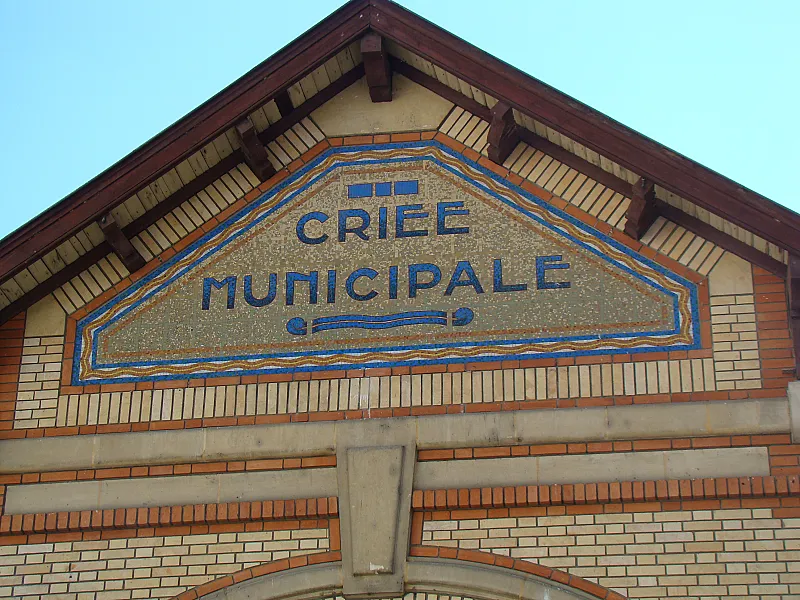
La Criée
- La Criée is a contemporary art center in Rennes, France, founded in 1986 and under municipal management since 1999.
- The center offers a varied program with exhibitions, artist residencies, colloquia and publications of collective and monographic works.
- The center referees notable exhibitions such as "DEHORS" by Yvan Salomone, "Flasques" by Christelle Familiari, "Brouillon" (group show), "La Rhétorique des marées, vol. 2" by Ariane Michel, among other.contemporaries.
- La Criée was awarded the label "center d'art contemporain d'intérêt national" in 2018.
Day 2 - Rennes
3 POIs to discoverDay 2 - Morning à Rennes
3 Points of interest - Duration : 3h30 - Distance : 0.5 km - Walking : 0h06
Église Toussaints de Rennes
- Toussaint Church, formerly the College Church, is a Catholic religious building in the counter-Reformation Baroque style.
- Built from 1624 to 1651, it was conceived as the church of the Collège Saint-Thomas, becoming a parish church in 1803.
- Under the Ancien Régime, it was rebuilt several times, the principal architects being Étienne Martellange, Charles Turmel and Pierre Goict.
- After the Revolution, the church underwent various uses before being demolished and rebuilt between 1801 and 1807, becoming the church of Toussaints.
- Classified as a historic monument in 1922, the church has been restored several times, most recently between 2013 and 2015.

Museum of Fine Arts of Rennes
- The Musée des Beaux-Arts de Rennes is a museum of art and archaeology, founded with works seized during the revolutionary confiscations in 1794, and thanks to the collection of the Marquis de Robien.
- The museum is located in Rennes' former university palace and features an encyclopedic collection covering European paintings and sculptures from the 14th to the 20th century, objets d'art from Europe, Africa and America, as well as regional and Egyptian antiquities.
- The collections include archaeological objects such as Egyptian fragments from various periods, drawings largely from the collection of President de Robien, and prints by artists such as Dürer, Rembrandt, and Watteau.
- Painting and sculpture from the 14th to 18th centuries include works by Rubens, Le Brun, Van Dyck, La Tour, as well as the Italian, French and Northern schools.
- The 19th to 20th century collection features works by Caillebotte, Gauguin, Boudin, Rodin, and contemporary artists such as Picasso.
- The museum also boasts a library specializing in art history and general archaeology, with over 32,000 books.

La Criée
- La Criée is a contemporary art center in Rennes, France, founded in 1986 and under municipal management since 1999.
- The center offers a varied program with exhibitions, artist residencies, colloquia and publications of collective and monographic works.
- The center referees notable exhibitions such as "DEHORS" by Yvan Salomone, "Flasques" by Christelle Familiari, "Brouillon" (group show), "La Rhétorique des marées, vol. 2" by Ariane Michel, among other.contemporaries.
- La Criée was awarded the label "center d'art contemporain d'intérêt national" in 2018.
Where to Stay in Rennes
When you have only two days in Rennes, location matters more than fancy extras: a well-placed base turns short walks into mini discoveries and gives you time for that unexpected coffee or evening show. The city is compact and lively, so choosing a neighborhood close to the sights you most want to see — or near a reliable transit point — will let you enjoy Église Toussaints de Rennes, the Museum of Fine Arts of Rennes and an evening at La Criée without hunting for taxis.
Rennes is organized around a charming medieval historic center of timbered streets and squares, a greener eastern belt around the parkland, and the transport hub near the station. The layout makes it easy to mix walking and short tram or bus hops: much of the center is pleasantly walkable, while the public network (metro lines and the STAR buses) covers longer hops and quieter residential quarters.
For proximity to Église Toussaints and the theatre vibe of La Criée, staying in the heart of the old town or along the nearby République/Parlements axis keeps you within easy evening strolls of restaurants and bars. If your priority is the art collection and a quieter, leafy atmosphere, look toward the area around Thabor and the museum: you’ll be a short walk from the Musée des Beaux-Arts and the park. If your trip is tightly scheduled or you’re arriving by train, the Gare / Saint‑Hélier side is practical for fast transfers and still places the centre a short metro or bike ride away.
Practical transport tips: rely on Rennes’ metro and STAR bus network for punctual short trips, consider the city’s bike‑share for flexible, scenic jaunts, and expect many central attractions to be reachable on foot in ten to twenty minutes. Taxis and rideshares fill in late‑night gaps but aren’t necessary for most daytime plans.
Finally, choose accommodation that fits how you like to travel: a central apartment if you want independent mornings, a guesthouse near Thabor for calmer nights, or a place by the station for stress‑free arrivals and departures. Rennes is small and forgiving — pick the location that matches your rhythm, and you’ll spend your two days exploring rather than commuting.
Getting Around Rennes
Rennes is delightfully easy to navigate: the city center is compact, the streets are walkable, and the public network is tidy and well-signed. The local operator, STAR, runs an efficient mix of metro lines and buses that connect the main sights, so even if you only have a day or two you won’t spend it lost in transit. Stations and stops are clearly marked, announcements are frequent, and many drivers and station staff speak enough English or are happy to point you in the right direction — so don’t be shy to ask. 🚇
A practical tip: purchase and carry a validated ticket for every journey. You can buy fares at station machines, kiosks, or via the official Korrigo app, and you’ll also find physical points of sale near the main squares. Remember that some services require you to validate your ticket on boarding or at the gate; keep your proof of purchase until you leave the system, because inspectors do make spot checks. 🎫
Use Google Maps (or the Korrigo app) in “public transport” mode and it’ll give you real-time departures, platform info, and step-by-step directions. Search for your destination — for example “Musée des Beaux-Arts de Rennes” or “La Criée” — and Maps will show the best combination of walking and transit, including how long each transfer takes. It’s especially handy for seeing when the next bus or metro comes so you don’t wait in the rain. 🗺️
To save money, consider a carnet (multi-ride ticket) if you’ll make several single trips, or a day pass if you’re planning lots of hopping around in one day. Weekly and monthly passes are economical if you’re staying longer. Small changes—like walking between close sights instead of jumping on a bus—add up and let you soak in more of Rennes’ charming streets and cafés.
On my first afternoon in Rennes I walked from Église Toussaints to the Museum of Fine Arts — a pleasant 10–15 minute stroll that let me admire the facades. Later that evening we needed to get to La Criée for a show, so I opened Korrigo, bought a single ticket, and hopped on a short metro ride that dropped us a five-minute walk from the theatre. The whole trip took less time than finding parking would have, and getting off at the right stop felt worry-free thanks to the clear station names and the app’s live directions — a tiny travel win that made the night feel effortless.
What to Pack for Rennes
Rennes is a compact, characterful city — narrow medieval streets, warm churches, and lively cultural corners. I’ve wandered its centre for full days, ducking into basilicas and small galleries; these six things kept me comfortable, respectful, and connected. Practical, light, and chosen for rainy Brittany weather and church visits.
1. Comfortable walking shoes (REQUIRED — e.g., waterproof low-profile trainers): I once walked nearly 15 miles in Rennes in a single day, cobbles and all, and my feet remembered it. Choose waterproof trainers or supportive walking shoes (think ECCO or Adidas Terrex) — they protect on cobbles and keep you going when you’re out for 10+ hours visiting churches and galleries. WHY: cobblestones + long walks = blisters fast; good shoes make the difference between enjoying a day and limping back to your hotel.
2. Cross-body bag (zippered, anti-theft): I always use a small zippered cross-body (around 4–6L) when I stroll markets or queue for a church. Rennes is generally safe, but crowded places like Marché des Lices or train stations are where you want your wallet close. WHY: hands-free comfort for photos and entrance lines, plus quick access to tickets and phone while deterring pickpockets.
3. Weather-appropriate clothing — layers + lightweight waterproof jacket: Rennes weather shifts fast; I’ve had sun at noon and drizzle by 3pm. Pack a breathable base layer, a light sweater, and a packable waterproof shell. WHY: indoor visits to churches and galleries can be cool, and outdoor promenades along the Vilaine or in Parliament Square can be windy — layers keep you comfortable without overpacking.
4. Power adapter (Type C/E, 230V) and short charging cable: French sockets use Type C and E (230V). I forgot an adapter once and had to hunt one down before an evening gallery opening. WHY: you don’t want dead devices when you need maps, tickets, or to take photos inside chapels and museums; a short cable is useful for cafés with crowded outlets.
5. Power bank (10,000–20,000 mAh): On a long day I’ve drained my phone fast — navigation, photos, and audio guides add up. A 10,000 mAh bank will recharge most phones 2–3 times; 20,000 mAh if you run multiple devices. WHY: keeps you powered for full days wandering (10+ hours) without hunting for plugs between churches and galleries.
6. Light scarf or modest cover-up (optional but recommended for church visits): Many churches appreciate modest dress; I keep a thin scarf in my bag to cover shoulders or head if needed. WHY: respectful entry into religious sites, and it doubles as a chill guard in drafty interiors or as sun protection outside.
Enjoy Your Trip to Rennes!
What a compact, joyful plan: two days in Rennes packed with history, art and local flavor. This 2-day, 3-spot itinerary takes you from the serene Église Toussaints de Rennes to the inspiring Museum of Fine Arts of Rennes and the lively atmosphere of La Criée — everything you need for a memorable weekend in the city.
Remember, this is a guide, not a rulebook: give yourself permission to be flexible and spontaneous. Above all, leave room for the unexpected — the real magic often happens in unplanned moments: wandering a side street, stumbling on a tiny gallery, or lingering in a café. Don’t pressure yourself to see EVERYTHING; relish slow discoveries and random detours instead.
I hope you feel excited and ready — I’m genuinely excited for you! Take in the architecture, the galleries, the quiet corners of churches and the laughter at La Criée. Embrace every moment, and know you’re about to create unforgettable memories in Rennes. You’re going to love it!
Want to explore in a playful way? Try Coddy’s interactive tour, The Alchemist RENNES — a gamified city exploration that turns discovery into a fun challenge. Check out our Coddy tours if you fancy a different, adventurous way to see the city!
Share your stories or ask questions if you like — I’m here to help. Safe travels! Have fun! Enjoy!
Want more adventure?
Discover our urban escape games to transform your visit into an interactive adventure!










